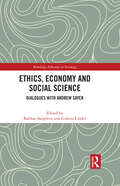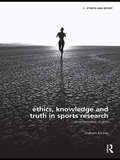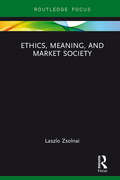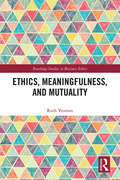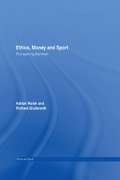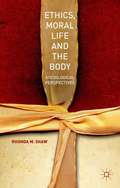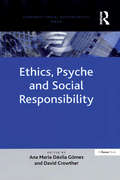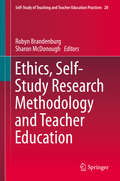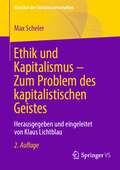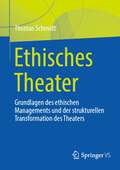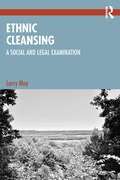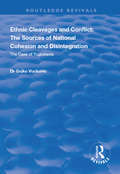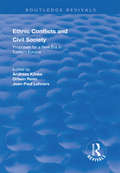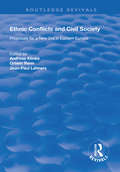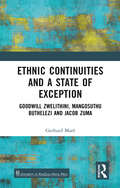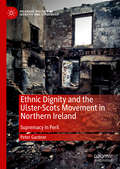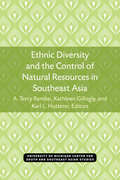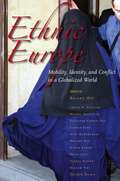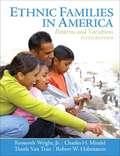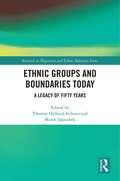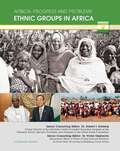- Table View
- List View
Ethics, Economy and Social Science: Dialogues with Andrew Sayer (Routledge Advances in Sociology)
by Balihar SangheraThis book is a collection of critical engagements with Andrew Sayer, one of the foremost postdisciplinary thinkers of our times, with responses from Sayer himself. Sayer’s ground-breaking contributions to the fields of geography, political economy and social theory have reshaped the terms of engagement with issues and debates running from the methodology of social science through to the environment, and industrial development to the ethical dimensions of everyday life. Transatlantic scholars across a wide range of fields explore his work across four main areas: critical realism; moral economy; political economy; and relations between social theory, normativity and class. This is the first full-length critical assessment of Sayer’s work. It will be of interest to readers in sociology, economics, political economy, social and political philosophy, ethics, social policy, geography and urban studies, from upper-undergraduate levels upwards.
Ethics, Equity and Community Development (Rethinking Community Development)
by Sarah Banks and Peter WestobyThis book offers a unique focus on the everyday ethics of community development practice in the context of local and global struggles for equity and social justice. Contributors from around the world (from India to the Netherlands and USA) grapple with ethical dilemmas and tensions, including how to: respect and learn from Indigenous values and philosophies; challenge environmental destruction; gain consent in divided communities; maintain or breach professional boundaries; and develop new paradigms for transformative community organising, sustainable development and ethically-sensitive practice. Offering theoretical frameworks, philosophical perspectives and practical case examples (from sex worker collectives to tree action groups and Australian Indigenous communities) this book is essential reading for community-based practitioners, students and academics.
Ethics, Knowledge and Truth in Sports Research: An Epistemology of Sport (Ethics and Sport)
by Graham McFeeThe study of sport is characterised by its inter-disciplinarity, with researchers drawing on apparently incompatible research traditions and ethical benchmarks in the natural sciences and the social sciences, depending on their area of specialisation. In this groundbreaking study, Graham McFee argues that sound high-level research into sport requires a sound rationale for one’s methodological choices, and that such a rationale requires an understanding of the connection between the practicalities of researching sport and the philosophical assumptions which underpin them. By examining touchstone principles in research methodology, such as the contested ‘gold standard’ of voluntary informed consent in the natural sciences and the postmodern denial of ‘truth’ in the social sciences, McFee demonstrates that epistemology and ethics are inextricably linked. Drawing on a wide range of examples, from the laboratory to the sports field, McFee explores the concepts of ‘knowledge’ and ‘truth’ in sports research and makes a powerful case for a philosophical deepening of our approach to method and methodology in sport. This book is important reading for all advanced students and researchers working in sport, exercise and related disciplines.
Ethics, Meaning, and Market Society (Routledge Focus on Business and Management)
by Laszlo ZsolnaiThis book explores the underlying causes of the pervasive dominance of ‘unethics’ in contemporary affairs in economics, business, and society. It is argued that the state of unethics is related to the overexpansion of market and market values in all spheres of social life and human activities. A correlate of this development is the emergence of an extremely individualistic, materialistic and narcissistic mind-set that dictates the decisions and behavior of people and organizations. The author argues that art can help to overcome the dominant market metaphysics of our age, as genuine art creates models of 'poetic dwelling,' which can generate non-linear, progressive change that opens up a larger playing field for ethics. Aesthetics and ethics go hand in hand. Ethical action is not just right for its own sake, but makes the world a richer, livable and more beautiful place. Ethics, Meaning, and Market Society will be of interest to students at an advanced level, academics, researchers and professionals. It addresses the topics with regard to ethics in economics, business, and society in a contemporary context.
Ethics, Meaningfulness, and Mutuality (Routledge Studies in Business Ethics)
by Ruth YeomanThere is an urgent need to understand how private and public organisations can play a role in promoting human values such as fairness, dignity, respect and care. Globalisation, technological advance and climate change are changing work, organisations and systems in ways which foster inequality, alienation and collective risk. Against this backdrop, organisations are being urged to make their contribution to the common good, take account of the interests of multiple stakeholders, and respond ethically as well as efficiently to complex challenges which transcend traditional organisational and state boundaries. Ethics, Meaningfulness, and Mutuality poses critical questions related to organisational design by challenging limits to current thinking, such as the neglect by political philosophers of markets, firms and stakeholders, or by organisational theorists of business ethics. In so doing, the book advances our understanding of the theory and practice of ethical organising. Specifically, meaningfulness and mutuality will be used to yield values and principles for a philosophy of ethical organising which includes an account of human values in morally desirable collective action, and examines the relationship of collective action to the contested concept of shared value creation. Within a philosophy of ethical organising, mutuality permits an examination of the unavoidable relational nature of collective action, whereas meaningfulness addresses fundamental human concerns for significance and leading a life we have reason to value. By addressing our status as relational beings with human needs for meaning, a philosophy of ethical organising brings critical thinking to the creation of morally informed organisational practices which are not only instrumentally beneficial for addressing wicked problems, but are normatively desirable for human flourishing.
Ethics, Money and Sport: This Sporting Mammon (Ethics and Sport)
by Richard Giulianotti Adrian WalshWritten from the contrasting yet complementary perspectives of sociology and philosophy, this book explores the far-reaching ethical consequences of the runaway commodification of sport, focusing on those instances where commodification gives rise to morally undesirable consequences. The authors consider three main areas of concern for participators and observers alike: the corrosion of the core meanings and values of sport, the increasing elitism of access to sporting commodities, and the undermining of social conditions that support sporting communities. Unique in its focus on the ethical dimension of the powerful economics of today’s sport, this book will be of interest, not only to those in the fields of sports studies and ethics of sport, but also to academics, researchers and students in philosophy of morality, sociology, and the ethics of globalization as viewed through the ultimate globalized phenomenon of modern sport.
Ethics, Moral Life and the Body: Sociological Perspectives
by Rhonda ShawShaw addresses the 'ethical turn' in contemporary sociological thinking, by exploring the contribution of sociology and the social sciences to bioethical debates about morality and tissue exchange practices.
Ethics, Psyche and Social Responsibility (Corporate Social Responsibility Series)
by Ana Maria GomezThe last few decades have seen significant changes in the structure of business organizations, including downsizing, outsourcing and flattened management structures. The effects on employees have been considerable. In this context the importance of the psychological contract between employer and employee has been overlooked, and there is uncertainty about what can be done to bring about changes to this contract and ultimately the future of organizations. This important book considers the psychological aspects of organizational life, particularly in the context of firms' ethical behaviour and its implications for corporate social responsibility. The authors consider the effects of corporate activity and change on individuals, not just in their working lives, but also in their family and social lives. They address a diverse number of topics from a variety of theoretical standpoints in an ongoing attempt to redress this neglected field of research.
Ethics, Self-Study Research Methodology and Teacher Education (Self-Study of Teaching and Teacher Education Practices #20)
by Robyn Brandenburg Sharon McDonoughThis book examines the nuanced and situated experiences of self-study researchers. It explores the ways in which ethics are dynamic, idiosyncratic and require an ongoing ethical reflexivity. In addition, the book identifies, documents and collates the collective experiences of self-study researchers and sheds new light on the role and impact of ethics, ethical dilemmas and ensuing decisions for education researchers.The book considers the ethical dilemmas that self-study researchers in teacher education face, their careful ethical considerations while conducting research, and how they form their professional judgment and understanding of what it means to be an ethical self-study researcher. For self-study researchers, there are a number of ethical dilemmas and challenges that cannot be neatly captured by the frameworks and guidelines of an ethics board. For many, this requires researchers to be ever-present and re-engaged with the ethics of their own projects, from the development, through to the dissemination of their work.Readers will gain a deeper understanding of ethics, ethical perspectives and practices in the field of self-study research.
Ethik und Kapitalismus – Zum Problem des kapitalistischen Geistes: Herausgegeben und eingeleitet von Klaus Lichtblau (Klassiker der Sozialwissenschaften)
by Max SchelerUnter den sich mit der historischen Genese und der epochalen Eigenart des modernen Kapitalismus befassenden Studien kommt den kapitalismuskritischen Schriften von Max Scheler (1874-1928) ein besonderer Stellenwert zu. Scheler, der in den zwanziger Jahren des vergangenen Jahrhunderts zusammen mit Karl Mannheim die moderne Wissenssoziologie begründete, hatte sich in die um 1900 zwischen Lujio Brentano, Werner Sombart, Max Weber und Ernst Troeltsch geführte Debatte über die religiösen Wurzeln des „kapitalistischen Geistes“ in einer sehr produktiven, heute weitgehend vergessenen Weise eingemischt und dabei eine höchst eigenwillige, durch die katholische Soziallehre geprägte Position vertreten. Bezüglich der Entstehung der modernen Wirtschaftsethik war er ähnlich wie Max Weber vor allem am Ethos jenes Menschentypus interessiert, der als Bürger und Unternehmer dem modernen industriellen Kapitalismus zum Durchbruch verhalf.
Ethisches Theater: Grundlagen des ethischen Managements und der strukturellen Transformation des Theaters
by Thomas SchmidtMit dem Konzept des Ethischen Theaters wird ein ganzheitliches Zukunftsmodell vorgestellt. Ausgangspunkt ist die Analyse der gegenwärtigen Krisen und der Komplexität in den deutschsprachigen Theatern, um die Grundlagen für ihren Transformationsprozess zu entwickeln. Mit dem Ethischen Theater wird ein Ziel dieses Prozesses vorgestellt: das ganzheitliches Zukunftsmodell einer Theater-Organisation des 21. Jahrhunderts, in der ethische Überlegungen erstmals in allen Prozessen handlungsleitend sind. Das Modell ist kompatibel mit den Interessen der Stakeholder und den wichtigen Reformprozessen, es ermöglicht die anstehende strukturelle Modernisierung der Theaterbetriebe. Unterstützt wird es durch das Konzept des Ethischen Theatermanagements, das erstmals über die klassischen Funktionen hinaus auch Aspekte der Diversität, der Nachhaltigkeit, der Ethik und der Zukunftsfähigkeit adressiert. Mit den erweiterten Funktionen des ethischen Managements werden auch weitere Möglichkeitsräume für die Zukunft der Kultur-Organisationen eröffnet.
Ethnic Cleansing: A Social and Legal Examination
by Larry MayPutting forward the argument that the strength of democracies can be measured in how well minorities – especially ethnic and racial minorities – are treated by the majority, Larry May’s Ethnic Cleansing maintains that unjust ethnic cleansing is one of the greatest internal challenges to the modern institutions of pluralistic and multicultural states.In order to determine what constitutes the crime of ethnic cleansing, this book details crucial conceptual issues around the topic, such as what ethnicity means, what ethnic cleansing claims to achieve, why these acts are invariably harmful, and the conditions of restitution, reparation, and reconciliation – affirming that ethnic cleansing must be countered by existing institutions such as the International Criminal Court, which is uniquely situated to prosecute ethnic cleansing.The first major study to analyze ethnic cleansing from an explicitly normative and conceptual perspective in the last decade, the increase in number and complexity of cases of ethnic cleansing makes this a timely book to understand the challenges that confront contemporary society.
Ethnic Cleavages and Conflict: The Sources of National Cohesion and Disintegration - The Case of Yugoslavia (Routledge Revivals)
by Gojko VuckovicFirst published in 1997, this volume explores ethnic conflict alongside the creation and disintegration of the short-lived Yugoslav state, 17 years after the death of Tito. Processes of democratization tend to elicit differences within the population along deep-seated ethnic, religious and cultural differences. Dr. Gojko Vuekovic argues that the situation is no different in post-Cold War Yugoslavia. By setting out Yugoslavia’s worst-case scenario of ethnic tensions, Dr. Vuekovic hopes to inform responses to ethnic conflict in the wider modern world.
Ethnic Conflict in Developing Societies
by Ann Marie BissessarThis book examines the experience of post-colonial territories and their attempts to manage ethnic communities within their countries. The study focuses on Trinidad and Tobago, Guyana, Suriname, and Fiji. This project looks at the mechanisms, which vary from legislation to political structures, systems, and institutions that have been introduced to allow for greater integration by these communities, and assesses their strengths and weaknesses.
Ethnic Conflicts and Civil Society: Proposals for a New Era in Eastern Europe (Routledge Revivals Ser.)
by Ortwin Renn Andreas Klinke Jean-Paul LehnersThis title was first published in 2000: The papers presented in this volume are based on the discussions of a workshop which asked: how can ethnic and political cooperation be accomplished in ethnically and politically heterogeneous countries after the collapse of the communist regimes which left a void for nationalist and even chauvinist movements? The objectives are: to promote a better understanding of the contemporary "ethnic" conflicts and their social, cultural and political causes; to determine the historical, structural and political developments that have led to or intensified these conflicts; to analyze and develop positive role models for coping with such conflicts; to provide constructive proposals for future conflict resolution mechanisms; and to identify the crucial elements for building trust-generating institutions on the basis of the civil society model. The papers address ethnic conflicts in Eastern Europe, with a particular focus on the former republics of Yugoslavia. They aim to go beyond the analysis of causes and manifestations of such conflicts and to offer constructive ideas for the post-Civil-War period.
Ethnic Conflicts and Civil Society: Proposals for a New Era in Eastern Europe (Routledge Revivals)
by Ortwin Renn Andreas Klinke Jean-Paul LehnersPublished in 1997. After the collapse of the communist system, the political systems in Eastern Europe were unable to cope with increasing tensions between ethnic majorities and minorities. These tensions led to violent ethnic conflicts and civil wars, in particular in former Yugoslavia. In this phase of transition and nation-(re)building, ethnic groups strove for more political autonomy and even territorial secession. The newly independent states lacked democratic structures and traditions as well as civil manners that could be used for regulating ethnic conflicts. The idea of Civil Society provides both basic democratic mechanisms for a lasting co-existence in an ethnically plural society. The theoretical part of this book discusses the issues of conflict anatomy, causes for conflict, and democratic conflict resolution. The empirical part describes experiences of ethnic conflicts in former Yugoslavia (especially Slovenia, Croatia and Serbia) in Ukraine and Romania. Experiences from Switzerland and the United States demonstrate successful examples of ethnic conflict management and illustrations of the political culture within a Civil Society.
Ethnic Continuities and a State of Exception: Goodwill Zwelithini, Mangosuthu Buthelezi and Jacob Zuma
by Gerhard MaréThis book alerts readers to the dangers of tradition as a formal, structured politics, which enriches a narrowly elite minority while overriding democratic rights, effecting a ‘state of exception’ for the governance of millions who are rendered as ‘subjects’ in South Africa. Gerhard Maré sets his focus on three powerful men – Goodwill Zwelithini, Mangosuthu Buthelezi and Jacob Zuma – to illustrate how, from different social locations, each has relied on claims to Zulu tradition to occupy powerful and financially rewarding positions.Print edition not for sale in Sub-Saharan Africa.
Ethnic Dignity and the Ulster-Scots Movement in Northern Ireland: Supremacy in Peril (Palgrave Politics of Identity and Citizenship Series)
by Peter GardnerIn this book, Peter Gardner contends that the production of narratives of ethnic peoplehood is an attempt to regain a sense of collective dignity among the previously dominant. After introducing the concept of ethnic dignity and locating its place within postconflict identity politics, Gardner focuses his analysis on the Ulster- Scots story of peoplehood. Drawing on a wealth of primary data, the chapters explore a variety of core issues including ethnopolitics, social class, political-economic ideology, colonialism, and heteromasculinity. The book concludes by taking a global view of post-conflict ethnic dignity among the once dominant, analysing the New Afrikaans movement in South Africa, white pride and ethnic whiteness studies, and Maronite Phoenicianism in Lebanon. This will be an important contribution for students and scholars of ethnicity, divided societies and, more broadly, political sociology.
Ethnic Diversity and Economic Instability in Africa
by Hiroyuki Hino John Lonsdale Gustav Ranis Frances StewartThere is growing consensus in the development economics literature that ethnic diversity is a very significant factor in explaining Africa's poor economic performance. Ethnic Diversity and Economic Instability in Africa challenges this conventional wisdom. Drawing on the insights of historians, anthropologists and political scientists as well as development economists, this book questions whether ethnicity is the most useful organising principle by which to examine the economic development of Africa, arguing that it is a more fluid and contingent concept than economic models allow. Instead, the authors explore the actual experience of ethnicity in Africa and propose new methods of measuring ethnic diversity and inequalities. Finally some tentative conclusions are reached regarding appropriate policy reforms.
Ethnic Diversity and the Control of Natural Resources in Southeast Asia (Michigan Papers On South And Southeast Asia #32)
by Karl L. Hutterer A. Terry Rambo Kathleen GilloglyThe authors consider the ways in which the high degree of ethnic diversity within the region is related to the nature of tropical Asian environments, on the one hand, and the nature of Southeast Asian political systems and the ways in which they manipulate natural resources, on the other. Rather than focus on defining the phenomenon of ethnicity, this book examines the different social evolutionary contexts in which the phenomenon is manifested. Companion volume to Cultural Values and Human Ecology in Southeast Asia (Michigan Papers no. 27).
Ethnic Europe: Mobility, Identity, and Conflict in a Globalized World
by Roland HsuOver the past several decades, Europe has become a destination for immigrants from all over the world. This volume examines the issues of ethnicity and immigration that face the European Union today, examining the struggle of EU nations to balance minority rights with social cohesion. Contributors look at issues including labor migration, strains on social welfare systems, separatist movements, the durability of local traditions, and the role of Islamic diasporas. Annotation ©2010 Book News, Inc. , Portland, OR (booknews. com)
Ethnic Families in America: Patterns and Variations
by Robert W. Habenstein Roosevelt Wright Charles H. Mindel Thanh Van TranReflecting the social and political dynamics in the United States, this edited volume offers an inclusive look at multicultural diversity in the U.S. with extensive coverage of the family life styles, traditions and values of seventeen American ethnic groups. <P><P>Providing unique and personal insights, each chapter is written by a contributing author representing a particular ethnic group and is structured in a similar pattern - covering the historical background, key ethnic cultural components, traditional and current ethnic family characteristics, and changes and adaptations to the ethnic family and culture. The book is suitable for undergraduate courses in Sociology of the Family, Sociology of Minority Groups, Social Work with Minority Groups, and Race and Ethnicity.
Ethnic Groups And Boundaries: The Social Organization Of Culture Difference
by Fredrik BarthThis classic is regarded as the seminal text from which stems much current anthropological thinking about ethnicity. This text opens with Barth's invaluable thirty-page essay that introduces readers to important theoretical issues in the analysis of ethnic groups.
Ethnic Groups and Boundaries Today: A Legacy of Fifty Years (Research in Migration and Ethnic Relations Series)
by Thomas Hylland Eriksen Marek JakoubekThe publication of Fredrik Barth’s Ethnic Groups and Boundaries marked a milestone in the conceptualization of ethnicity and ethnic groups and opened a new field of enquiry in the social scientific study of ethnicity. Ethnic Groups and Boundaries Today: A Legacy of Fifty Years demonstrates the enduring significance of the work, identifying its shortcomings and showcasing the state of the art today, fifty years after the publication of the groundbreaking original. Bringing together a team of leading contributors, all of whom have been inspired by Barth's theory and have made significant contributions of their own to the theorisation and research of ethnicity, this volume assesses the theoretical approach presented in Ethnic Groups and Boundaries, both in the context of its time and with the hindsight of the developments in the social sciences since then. It emphasizes the legacy of the original text and determines its significance, whilst identifying and elaborating on the main lines of the subsequent developments of the concept of ethnicity that were influenced by Ethnic Groups and Boundaries, but that have since developed and superseded the original. As such, it will appeal to scholars across the social sciences with interests in the concept and study of ethnicity.
Ethnic Groups in Africa (Africa: Progress and Problems #13)
by Elizabeth ObadinaEthnic or racial classifications often say more about culture and shared experience than about genetics or common ancestry. In Africa, a continent where up to 3,000 languages are spoken, ethnicity can be especially difficult to define. Unfortunately, perceived ethnic differences have all too often produced tragic results. This book analyzes the role of ethnicity in contemporary African politics and governance. It examines the corrosive legacy of the slave trade and European colonization, details some of the bloody conflicts that have erupted from ethnic frictions, and describes how divisions that appear to be ethnically based often have more to do with class and religion. The book also explores the possibility of a united Africa, able to harness its diversity rather than fight over its differences.
